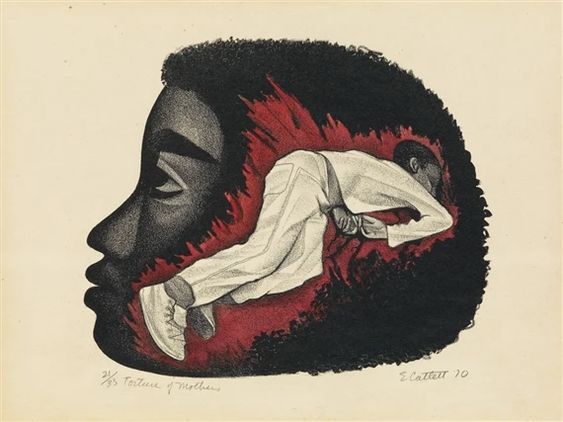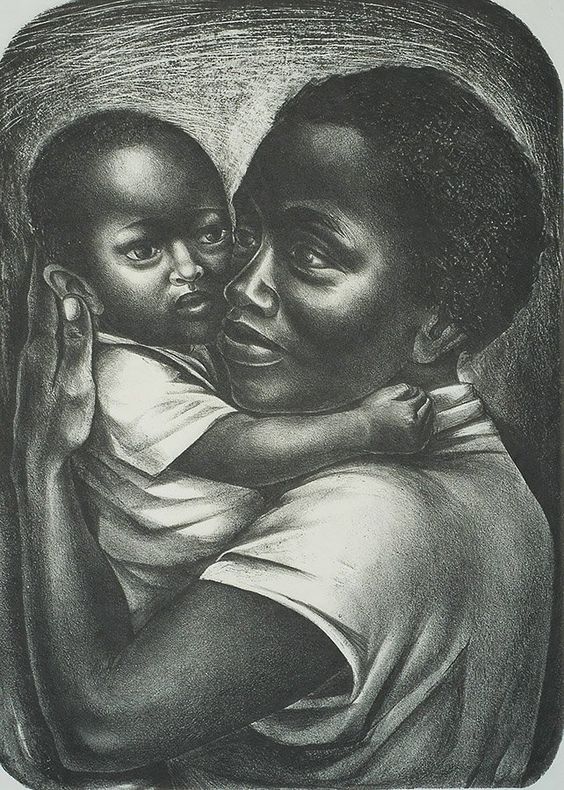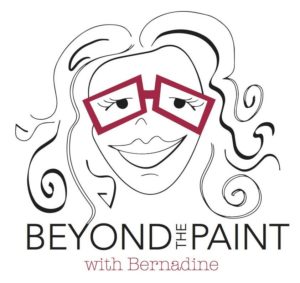Elizabeth Catlett was a black, female artist, sculptor and printmaker. She was best known for her depictions of the African-American experience which often focused on the female experience. Her granddaughters Ife and Nia Mora are extension of Catlett’s deep and resonant legacy. In this episode we explore the ways Catlett’s work, practice and social activism shape and inspired the lives of her granddaughters. We talk art, activism, motherhood, resilience, self and intergenerational healing and Catlett’s passion for cooking Mexican and Black Soul food recipes for gatherings.
Ife Mora Bio: Follow Ife @ife.mora
Ifé Mora is a Trauma Informed Somatic healer, Buddhist teacher, musician, and self-defense instructor who uses embodiment practices to help heal people of their trauma and create mental and emotional wellness. She integrates Somatic Experiencing, Polyvagal theory, mindfulness, meditation, movement, and visualization exercises to extract stored trauma trapped in the body and nervous system while also providing tools to build resiliency and create healing resources for self-regulation. Ifé is a Black-Mexican native of Detroit and longtime resident of New York City who is committed to helping communities impacted by intergenerational trauma, racism and law enforcement thrive. As a professional musician, Ifé believes that art, science, spiritual practices, and medicine all have a role to play in helping people transform their lives. Ife currently resides in Los Angeles with her partner and son.
Ifés’ workshops are a safe group healing circle where participants will have an opportunity to do a somatic visualization exercise to build resources for healing trauma from the body. Research shows that somatic visualization exercises help with reducing stress, easing anxiety, and building tools to regulate the nervous system if triggers are experienced. This will be a fun, enlightening, and healing workshop for anyone who suffers from symptoms of trauma, anxiety, or depression.
Nia Mora Bio—Follow Nia @niamora1
Nia Mora was raised between Detroit City and Mexico City, a bicultural experience that shaped her enthusiasm for travel and heritage exploration. She completed a BFA in Fine Art and photography at SVA in NYC. This cultivated a love for the visual arts and an appreciation for the work of her paternal grandparents, Elizabeth Catlett and Francisco Mora Sr. After several years immersed in the arts in NYC, Nia decided to travel the world and the beauty its natural wonders had to offer her. She moved to Hawaii at the age of 27 and from there sailed across the Pacific Ocean. This type of travel lent a a sense of strength and humility to Nia’s understanding of the world. She also became captivated by international cuisine.
Chef Nia began her culinary career whilst sailing around the world. In 2012, she started cooking in different countries across the Pacific in order to fund her maritime adventures. The call of distant island nations encouraged her to discover an entire new and delicious experience. After her arrival to New Zealand, Nia commenced her training in charcuterie and wine-food pairing; thereafter, fulfilling an entire harvest season at a five star vineyard in the Hauraki Gulf. The freshly harvested seafood from the banks of New Zealand, sparked a sense of connection between the ocean and its edible treasures. Nia developed a sensibility and appreciation of the connection between food and how nature sustains us. Like a well nurtured vine, a passion for cuisine slowly grew. This propelled her to complete a Chefs License within a year of intensive hands-on apprenticeship in Brisbane, Australia. Witnessing how food could bring people together, ignited her career as a private yacht chef, bridging her love for the sea and the culinary arts.
Finding a home in the British Virgin Islands, she has now committed her culinary excites to the yachting community and strives to share new imaginative dishes that stem from the influences of her native Afro-Mexican culture. Her cuisine is also influenced by the colorful cultures that have cultivated her culinary journey. Chef Nia offers a versatile and international gastro experience.
Works Highlighted include:


Script: Hello my Art Enthusiasts! Welcome today’s show, Episode 158
Today is a very special show—my heart is truly overflowing as I welcome the granddaughters of black, female artist; sculptor and printmaker Elizabeth Catlett. Ife Mora and Nia Mora. Before I welcome my guests,
I connected with Catlett’s granddaughter Ifa, a Trauma Informed Somatic healer, Buddhist teacher, musician, and self-defense instructor who uses embodiment practices to help heal people of their trauma and create mental and emotional wellness. We connected through Instagram and through Ife, I was introduced to Nia Mora, a photographer, world traveler and chef, she built an inspiring culinary career as a private yacht chef, bridging her love for the sea and the culinary arts. Through my interactions and conversations with Ife and Nia, my enthusiasm for Catlett’s work has only deepened. I produced two podcast shows celebrating Catlett, including a recording of a talk I led on Black Female Printmakers at the New Britain Museum of American Art this past February.
You can listen to those episodes, numbers 144 and 150, I put links in the podcast notes for a deeper dive into Catlett’s artistic practice and work. Elizabeth Catlett was an American and Mexican graphic artist and sculptor best known for her depictions of the African-American experience in the 20th century, which often focused on the female experience.
As the observer of Catlett’s work, especially her portrayals of black women expressed through a mixture of the Modernist tradition with influences from African and Mexican art traditions, I am moved by the humanity, grace and dignity she brings to the women she portrays; many of them are anonymous. In her prints, she honors black women through expressiveness of the line, dramatic contrasts, abrupt cropping of the figure—she offers a unique viewpoint of black women and their beauty. Her sculptures are monumental expressions that portray the beauty of black women, creating forms that vascillate between naturalism and abstraction.
Imagine growing up with Ms Catlett, the artist, as her granddaughter and all the ways her artistic life shaped the women closest to her. I want to welcome Ife and Nia—thank you for being here on my show. In our conversations leading up to this episode, you shared with me works that really resonated with you. So let’s start with a couple of the works as an entryway to our conversation. We will focus on three themes that thread through her work; motherhood, her expressions of police brutality and the female reclining nude. First, motherhood: paramount in her work
“Black Maternity,” a lithograph from 1950 depicts a black woman embracing her toddler son. Her cheek presses into the young boys; her left arm and hand embrace the boy but also for me, creates this maternal shield of protection; her face is sculptural with high cheekbones, a wide, open smile; the boy leans into his mother, arm and hand are wrapped around her neck. So beautiful, elegant and yet ordinary.
Or in the work, the terra cotta sculpture, “Mother and Child,” from 1956. We experience a tender moment between a mother and her young son. The boy is in his mother’s lap, (from the MOMA) “intimacy lies in the way the weight of the child’s face presses against the mother’s breast; the mother’s head lowered is nestled against the child’s scalp, breathing in the smell—the work is both affectionate and shielding.” Even if you never held your own child, Catlett’s own experience as a mother, her memories are visually captured, “the idea of remembering something fleeting, the sculpture is a tiny memorial to the love between a mother and child. “
Can you share the ways your grandmother’s her portrayals of motherhood resonate with you?
Your grandmother was an activist taking on the injustices of “police brutality,” in her art. Created in the 20th century her works are hauntingly relevant today. “The Torture of Mothers,” a hand colored lithograph from 1970. We see the profile of a black woman, her gaze looks upward, her expression tense. Within her profile is the body of a young man, dressed in white, he wears white pants, shirt, sneakers, his arms are somewhat twisted beneath him, surrounding his body is scarlet, red, bold, thick jagged line. It depicts the killing of a young, black man by police. For me, the jagged lines portray not just his life, severed unjustly, it expresses the anger and grief of a mother for her son.—it is a heartbreaking depiction and reminder of America’s slow progression toward achieving genuine equality among races—Catlett, ahead of her time, her work strived for this.
Ife: How did your grandmother’s political views expressed in her prints of police brutality influence your work as a Somatic healer of trauma? For those who do not know, can you share what is a somatic healer?
One of the passions of Ms Catlett, your grandmother had, was centered on food and family gatherings. Nia, our celebrated chef, Chef Nia and a photographer with an eye for food styling, Can you share a couple of memories or stories of your grandmother’s cooking and the ways it inspired and influenced your culinary life?
I want to wrap up with another work by your grandmother, which reflects her desire to express black woman in all their beauty and nobility—this is through the reclining female nude figure. Which are so sensuous, powerful— Ife, a mahogany wood sculpture from 2002 is of a woman reclining on her right elbow, with her body tilted toward the viewer. Her left arm rests over her stomach, her left hand on her right thigh. Her left leg, bent at the knee, points upward. Ife “refers to the Ife people and culture that flourished in West Africa from the 1000s to the 1500s. The name also describes the place where they believe life began, and Catlett interprets that African creation myth as a proud and powerful Earth goddess.” The sculpture is smooth with curved forms embodying the source of human life.
How did your grandmother’s portrayals of the reclining, female nude shape the way you see black bodies?
Your grandmother said, “I have always wanted my art to service my people — to reflect us, to relate to us, to stimulate us, to make us aware of our potential.” Can you each share how her life, her artistic practice, “services” the way you carry yourselves in your lives, the ways you see your own potential? For me, her work steered me towards a deeper empathy for people, and for their experiences.
You both were blessed to be able to reside within her sphere, of curiosity, courage, intellect, those she surrounded herself with, and I admire your deep desire to bring awareness to your grandmother’s work and life to a broader audience. I thank you—In the podcast show notes I will add links to your social media platforms so others can connect with you and reach out to you about your work and your grandmother, Elizabeth Catlett.
